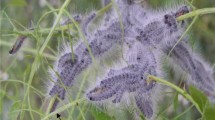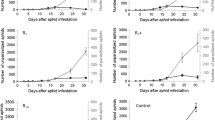Abstract
The impact of gall-inducing aphids on shoot development was analyzed in 900 shoots from 20 pistachio trees, Pistacia atlantica Desf. (Anacardiaceae): 600 in which the axillary—lateral buds were galled by Slavum wertheimae HRL during the previous growth season, and 300 ungalled shoots. Although P. atlantica is a compensating tree, and the aphids do not attack the apical buds, further development of shoots from the apical buds was stopped in 62% of the galled shoots, while only 8.7% of nongalled shoots stopped their growth. Further development was stopped more often on shoots carrying two or more galls than on shoots supporting only one gall. To assess the hypothesis that bud destruction by the aphids explains this pattern, a field experiment was conducted in 140 shoots, distributed across seven trees. One, two or three axillary buds from five shoots of each tree were removed for each treatment, and five other shoots were marked as controls. Only 14 shoots (10%) of the 140 did not develop. The growth of the other shoots was not very different among the treatments. The colonization of the apical shoots, which developed on previously treated shoots, by three other galling aphid species was monitored. Removing lateral buds considerably reduced the establishment of Geoica sp. galls (70% of them colonized control shoots), but weakly influenced Forda riccobonii (Stefani). It also contributed only 5% of the total variance of the distribution of Smynthurodes betae West. The different results of the survey and the experiment show that the impact of S. wertheimae galls on the future growth of shoots from apical buds is more complex than the simple physical destruction of the axillary buds.
Similar content being viewed by others
References
Aloni R, Katz DA, Wool D (1989) Effect of gall-forming aphid Slavum wertheimae on the differentiation of xylem in branches of Pistacia atlantica. Ann Bot 63:373–375
Blackman RL, Eastop VF (1994) Aphids on the world’s trees: an identification and information guide. CAB International, Wallingford
Bodenheimer FS, Swirski E (1957) The Aphidoidea of the middle east. Weizmann Science of Israel, Jerusalem
Burstein M, Wool D, Eshel A (1994) Sink strength and clone size of sympatric, gall-forming aphids. Eur J Entomol 91:57–61
Davatchi GA (1958) Etude comparative sur la biologie et le polymorphisme des aphides gallicoles des Pistacia d’Asie Centrale, du Moyen-Orient, du bassin méditerranéen et du Nord Africain. Revue de Pathologie Entomologique Agricole Française 37:85–166
Hood G (2006) PopTools, version 2.7. http://www.cse.csiro.au/poptools
Inbar M, Wool D (1995) Phloem-feeding specialists sharing a host tree: resource partitioning minimizes interference competition among galling aphid species. Oikos 73:109–119
Jones CG, Lawton JH, Shachak M (1996) Organism as ecosystem engineers. In: Samson FB, Knopf F (eds) Ecosystem management. Springer-Verlag, New York, pp 130–147
Katz D (1991) Differentiation of vascular tissues in host trees in response to parasitic plants or animals. Thesis submitted to the Senate of Tel Aviv University, for the degree “Doctor of Philosophy” (in Hebrew)
Kurzfeld L, Wool D, Inbar M (2003) Gall-forming aphids as tree architects. Isr J Zool 49:81
Larson KC, Whitham TG (1991) Manipulation of food resources by a gall forming aphid: the physiology of sink–source interactions. Oecologia 88:15–21
Martinez J-JY, Wool D (2003) Differential response of trees and shrubs to browsing and pruning: the effects on Pistacia growth and gall-inducing aphids. Plant Ecol 169:285–294
Martinsen GD, Driebe EM, Whitham TG (1998) Indirect interactions mediated by changing plant chemistry: beaver browsing benefits beetles. Ecology 79(1):192–200
Mopper S, Maschinski J, Cobb N, Whitham TG (1991) A new look at habitat structure: consequences of herbivore-modified plant architecture. In: Bell SS, McCoy ED, Mushinsky HR (eds) Habitat structure—the physical arrangement of objects in the space. Chapman and Hall, London
Onay A, Cigdem I, Filiz A (2005) Pistacia vera Pistacio. In: Litz RE (ed) Biotechnology of fruit and nut crops. Biotechnology in Agriculture Series, vol 29. CABI Publishing, pp 62–73
Perevolotsky A, Seligman NG (1998) The role of grazing in Mediterranean rangeland ecosystems. Bioscience 48:1007–1017
Rosecrance RC, Weinbaum SA, Brown PH (1998) Alternate bearing affects nitrogen, phosphorus, potassium and starch storage pools in mature pistachio trees. Ann Bot 82:463–470
Statistix Version 4.0 (1992) Analytical software. Tallahassee, FL, USA
Tscharntke T (1989) Changes in shoot growth of Pragmites australis caused by the gall maker Giraudiella inclusa (Diptera: Cecidomyiidae). Oikos 54:370–377
Weis AE, Kapelinski A (1984) Manipulation of host plant development by a gall midge Rhabdophaga atrobiloides. Ecol Entomol 9:457–465
Wool D (1984) Gall forming aphids. In: Ananthakrishnan TN (ed) Biology of gall insects. Oxford and IBH, New Delhi, pp 11–58
Wool D (1995) Aphid-induced galls on Pistacia in the natural Mediterranean forest of Israel: which, where, and how many. Isr J Zool 41:591–600
Wool D (2003) Gall-inducing aphids: biology, ecology and evolution. In: Raman R, Schaefer CW, Withers TM (eds) Biology, ecology, and evolution of gall-inducing arthropods. Science, Enfield, pp 73–132
Wool D, Bogen R (1999) Ecology of the gall-forming aphid, Slavum wertheimae, on Pistacia atlantica: population dynamics and differential herbivory. Isr J Zool 45:247–260
Wool D, Burstein M (1991) A galling aphid with extra life-cycle complexity: population ecology and evolutionary considerations. Res Popul Ecol 33:307–322
Wool D, Manheim O (1988) The effects of host-plant properties on gall density, gall weight and clone size in the aphid Aploneura lentisci (Pass.) (Aphididae: Fordinae) in Israel. Res Popul Ecol 30:227–234
Zar JH (1984) Biostatistical analysis, 2nd edn. Prentice-Hall, Englewood Cliffs, p 241
Zohary M (1952) A monographical study of the genus Pistacia. Palest J Bot 5:187–228
Acknowledgements
The author would like to thank Hagar Erez and Hagar Tziper for their technical assistance in the fieldwork, and David Wool and Lilah Kurzfeld who commented an earlier draft of this manuscript.
Author information
Authors and Affiliations
Corresponding author
Additional information
Handling editor: Graham Stone
Rights and permissions
About this article
Cite this article
Martinez, JJ.I. Impact of a gall-inducing aphid on Pistacia atlantica Desf. trees. Arthropod-Plant Interactions 2, 147–151 (2008). https://doi.org/10.1007/s11829-008-9042-7
Received:
Accepted:
Published:
Issue Date:
DOI: https://doi.org/10.1007/s11829-008-9042-7




